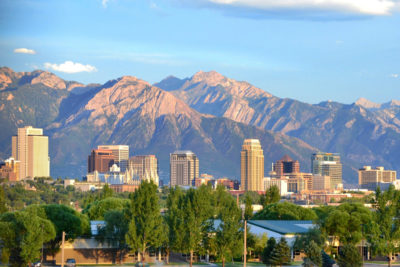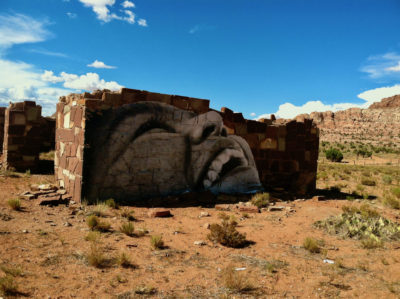The Presence and Persistence of Stories: An NCPH annual meeting call for proposals
08 June 2020 – Laurie Arnold and Leisl Carr Childers
A long time ago, in fall 2019, before a global pandemic rearranged our world, we began drafting the 2021 National Council on Public History annual meeting theme and extending invitations to serve on the program committee. We were looking forward to bringing the conference back to the West, a West entirely distinct from both Las Vegas and Monterrey, and to building a conference around place and narrative. The 2021 conference theme, “The Presence and Persistence of Stories,” celebrates stories (the narratives that form the cornerstones of our relationship to the land and each other) and histories (the methodologically-grounded studies and interpretations of the past) and explicitly grounds them in the lands of their telling. We invite you to submit an early topic proposal by June 10 or a complete presentation proposal by the final July 15 deadline.

Salt Lake City skyline, August 2012.
“Looking forward” has taken on new meaning in spring 2020. As we plan to hold the March conference in Salt Lake City, we do so in a world filled with uncertainty and anxiety about public health, racial injustice, and economic security. We know that it is difficult to plan ahead in these circumstances. Nevertheless, we also know that this current moment is a story unto itself worthy of commemorating. We want to hear and share these and other stories with our friends and colleagues next year, but are also keenly aware that right now we have more questions than answers. Nevertheless, we think it important to begin imagining how those stories could be told in 2021.
As we think about the July 15 CFP deadline and the June 10 early topics proposal deadline, we are encouraged to see so many people across the globe advocating for the end of structural racism and for police accountability in the midst of documenting their lived COVID-19 experiences on social media and creating primary source materials through interviews, eye-witness accounts, journaling, and film making. We can’t wait to engage historians as they contextualize this incredible moment of social protest in the midst of physical distancing in broader discourses of racial justice and civic engagement, pandemic disease, and public health.

Jetsonorama (Chip Thomas) art on the Navajo Nation near Page, Arizona, 2012. Photo credit: Leisl Carr Childers
We also look forward to focusing on Indigenous storytelling, the telling of under-told stories, and what it means to speak stories to future generations. The place we currently know as Salt Lake City resides on the ancestral homelands of the Eastern Shoshone and Goshute tribes. We are fortunate that local tribal leaders and storykeepers, those responsible for communicating the stories that connect the people to the land and each other, will join us all and share community best practices for public interpretation and storytalking, the delivery of these critical stories by storykeepers, which advance tribal priorities and narratives. In addition, the United States is the ancestral homeland of a multitude of Indigenous peoples, from the Lenape in Manhattan and the Cherokee peoples in Georgia, Arkansas and Missouri, and Oklahoma, to the Navajo Nation in the Southwest and the Spokane peoples in the Northwest. Each have their own stories, their own deep connections to these homelands and community-based storytelling traditions.
Those of you who have been to the Salt Lake region share our enthusiasm to return, and if 2021 will be your first visit, you will experience the diverse culture and history the region has to offer. Located between the ever-changing shoreline of the Great Salt Lake and the soaring mountains of the Wasatch Range, Salt Lake City is uniquely configured at the eastern edge of the Great Basin and the western portal to the Rocky Mountains. Salt Lake City is a hub of outdoor recreation and an epicenter of the interior West. It also has some of the region’s best microbreweries and distilleries, restaurants and cafes, art and history museums, music, and ballet. It is a place where multiple faiths are embedded in the fabric of the city in places such as Temple Square, the Cathedral of the Madeleine, the Buddhist Temple, and the Summum Pyramid, and where the past is actively present in public spaces in monuments such as those to the Pony Express, Church of Jesus Christ of Latter Day Saints leader Brigham Young, and the 2002 Winter Olympics. The city houses the largest genealogical library in the world, and its history challenges us to better understand who we are as a nation. It is a fantastic venue in which to focus on under-told stories
Designing a conference program is among the most rewarding ways we can contribute to our discipline. The 2021 program committee is comprised of exceptional professionals; we are grateful to be collaborating with such generous colleagues and peers. Despite the uncertainty, we truly are “looking forward” to spring 2021, and to gathering with all of you in Salt Lake City, the namesake of the Goshute Pi’a-pa/Ti’tsa-pa, the locus of Deseret, a hub of the international refugee community, and the heart of the Jell-O Belt. We hope that you will look closely at this place and think carefully about this moment that is rich with stories of past and present for the 2021 conference. In the meantime, we wish you good health, safe homes, and strong community.
~Laurie Arnold is an enrolled member of the Sinixt Band of the Colville Confederated Tribes. She is director of Native American Studies and an associate professor of history at Gonzaga University. Her research interests include contemporary Native American drama, the Indigenous Columbia Plateau, and federal Indian policy.
~Leisl Carr Childers is an assistant professor at Colorado State University. She is a faculty council member at the Public Lands History Center and co-investigator of a new administrative history of the USDA Forest Service since 1960. Her research interests include the history of public lands management and horse culture in the American West.




